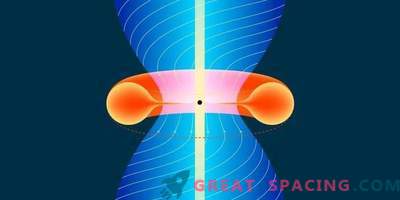
Magnetohydrodynamic three-dimensional modeling of a relativistic jet
Representatives of the National Institute of Astrophysics revealed a kind of spiral blazar jet with a multitude of twists. Blazar is an astronomical object in an elliptical galaxy occupied by a central supermassive black hole. Known for emitting high-energy particles. Scientists see them if the source is directed to Earth. This is one of the most energetic phenomena in space.
In the second half of 2017, the blazer CTA 102, distant from us by 7,600 million light years, created an incredible flash. The peak emission came on December 28, when the brightness exceeded previous lows by 3,500 times. This event is so unusual that for several days the object remained the brightest ever observed.
To conduct a survey, scientists used the Astrophysical Observatory of Turin, connecting more than 40 telescopes in the Northern Hemisphere. They observed in the visible, radio and near infrared range, which allowed us to detail the light curves. A huge amount of information helped to test the hypothesis. She argued that the variability of the object is due to changes in the relativistic Doppler factor. It turns out that the vortex jet is devoid of homogeneity, since it creates radiation from different zones, which change their location due to the instability of the jet or orbital motion.
An incredible increase in the brightness level is associated with an increase in the alignment of the emitting zone of the jet with our line of observation. Now the model used in the study received not only theoretical, but also observational confirmation.
Three-dimensional numerical simulation with allowance for magnetohydrodynamic properties and relativistic velocities predicts the appearance and propagation of instabilities in the jet, which will then distort it. In addition, images from a radio interferometer show that the jet acquires a spiral shape and contains a huge amount of vortices.











































